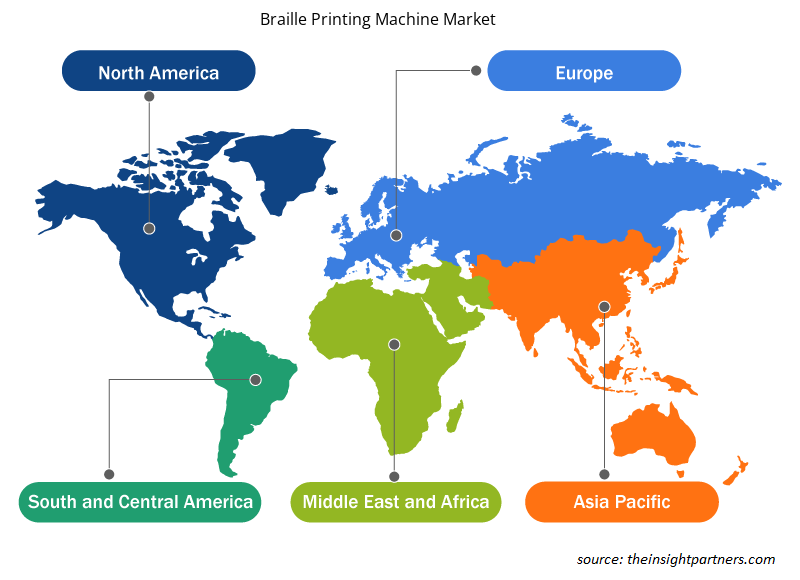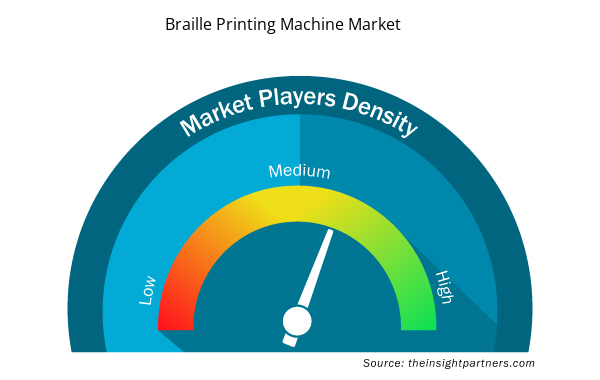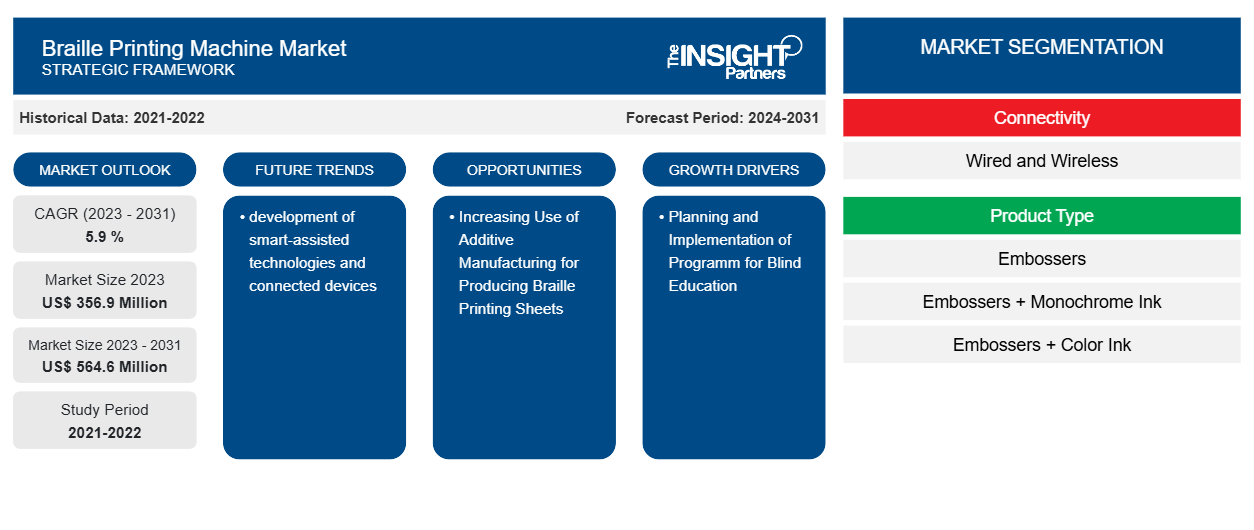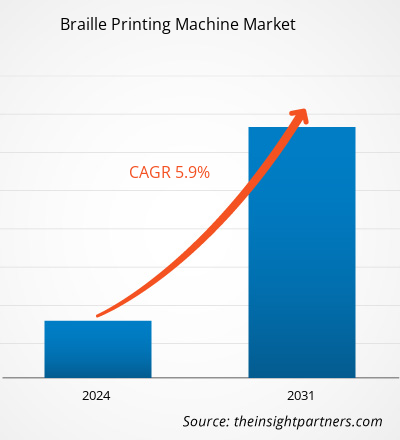Si prevede che la dimensione del mercato delle macchine da stampa braille raggiungerà i 564,6 milioni di dollari entro il 2031, rispetto ai 356,9 milioni di dollari del 2023. Si prevede che il mercato registrerà un CAGR del 5,9% nel periodo 2023-2031. È probabile che lo sviluppo di tecnologie assistite da smart e dispositivi connessi rimanga una tendenza chiave nel mercato.
Analisi di mercato delle macchine da stampa Braille
La macchina per la stampa braille è una stampante collegata a un computer che viene utilizzata per produrre una copia braille del testo. Una stampante braille può anche essere collegata a dispositivi per prendere appunti braille per lo stesso scopo. Con l'uso di una stampante braille, uno studente può stampare una copia braille dei propri appunti e del proprio lavoro di scrittura. Le stampanti braille richiedono carta pesante e la maggior parte dei modelli stampa su un solo lato.
Panoramica del mercato delle macchine da stampa Braille
Le stampanti Braille ricevono informazioni dai dispositivi informatici e le imprimono in Braille sulla carta tramite l'uso di solenoidi che controllano i perni di stampaggio. Le stampanti Braille in genere utilizzano più pagine per la stessa quantità di informazioni rispetto alle pagine stampate su una stampante normale. Le stampanti Braille, note anche come stampanti Braille, possono rendere molto più facile per i non vedenti stampare documenti leggibili se si ha una disabilità visiva. Dai documenti importanti alle copie di backup di lettere e moduli, una stampante Braille può essere un'utile aggiunta alla vita di tutti i giorni.
Personalizza questo report in base alle tue esigenze
Riceverai la personalizzazione gratuita di qualsiasi report, comprese parti di questo report, o analisi a livello nazionale, pacchetto dati Excel, oltre a usufruire di grandi offerte e sconti per start-up e università
- Scopri le principali tendenze di mercato in questo rapporto.Questo campione GRATUITO includerà analisi di dati che spaziano dalle tendenze di mercato alle stime e alle previsioni.
Driver e opportunità del mercato delle macchine da stampa Braille
Pianificazione e attuazione del programma per l'istruzione dei ciechi a favore del mercato
La NFB BELL Academy offre ai bambini con abilità Braille e non visive una formazione attraverso attività di apprendimento divertenti e pratiche. A seconda della sede, le attività vengono fornite in un programma giornaliero o in una sede residenziale. Il programma è progettato per bambini ciechi e ipovedenti dai quattro ai dodici anni. Scopri di più sulla NFB BELL Academy. Tuttavia, Advocacy and Awareness, The National Association for the Blind Delhi, si impegna in sforzi di advocacy per aumentare la consapevolezza sull'importanza dell'istruzione inclusiva e per sostenere politiche che supportino i diritti degli studenti ipovedenti a ricevere un'istruzione di qualità in contesti tradizionali. Tali iniziative guidano la crescita del mercato a livello globale.NFB BELL Academy offers children with Braille and non-visual skills training through fun, hands-on learning activities. Depending on the location, activities are provided in a day program or residential location. The program is designed for blind and low-vision children ages four through twelve. Learn more about the NFB BELL Academy. However, Advocacy and Awareness, The National Association for the Blind Delhi, engages in advocacy efforts to raise awareness about the importance of inclusive education and to advocate for policies that support the rights of visually impaired students to receive quality education in mainstream settings. Such initiatives globally drive the growth of the market.
Utilizzo crescente della produzione additiva per la produzione di fogli di stampa Braille
La stampa Braille aiuta le persone cieche e ipovedenti a leggere, motivo per cui viene utilizzata ovunque. La stampa Braille sulle confezioni aiuta le persone cieche a orientarsi meglio e a ottenere informazioni. In particolare nel caso di confezioni per medicinali, si applicano obblighi di etichettatura speciali, anche in Braille. Grazie alla sua enorme applicazione, la produzione additiva viene utilizzata per produrre fogli di stampa Braille. Pertanto, aumentare l'uso della produzione additiva per la produzione di fogli di stampa Braille crea un'opportunità redditizia per la crescita del mercato.
Analisi della segmentazione del rapporto di mercato delle macchine da stampa Braille
I segmenti chiave che hanno contribuito alla derivazione dell'analisi di mercato delle macchine da stampa Braille sono connettività, tipo di prodotto, applicazione e settore.
- In base alla connettività, il mercato delle macchine da stampa Braille è suddiviso in cablate e wireless.
- In base al tipo di prodotto, il mercato delle macchine per la stampa Braille è suddiviso in goffratrici, goffratrici + inchiostro monocromatico e goffratrici + inchiostro a colori.
Analisi della quota di mercato delle macchine da stampa Braille per area geografica
L'ambito geografico del rapporto di mercato sulle macchine da stampa braille è suddiviso principalmente in cinque regioni: Nord America, Asia Pacifico, Europa, Medio Oriente e Africa e Sud e Centro America. Organizzazioni e individui in tutto il mondo hanno sostenuto una maggiore consapevolezza e accessibilità ai materiali e alla tecnologia braille. Nel 2021, sostenitori ed esperti in Camerun hanno celebrato la Giornata mondiale del braille (4 gennaio) con attività e un raduno. I giornalisti hanno osservato che "i dimostranti ciechi hanno affermato che il sistema braille li aiuta a migliorare la loro istruzione, a stabilire la loro indipendenza e a ridurre la necessità di supporto" e hanno chiesto un maggiore supporto per gli educatori affinché apprendano "il braille negli istituti di formazione degli insegnanti".
Approfondimenti regionali sul mercato delle macchine da stampa Braille
Le tendenze regionali e i fattori che influenzano il mercato delle macchine da stampa Braille durante il periodo di previsione sono stati ampiamente spiegati dagli analisti di Insight Partners. Questa sezione discute anche i segmenti e la geografia del mercato delle macchine da stampa Braille in Nord America, Europa, Asia Pacifico, Medio Oriente e Africa e America meridionale e centrale.

- Ottieni i dati specifici regionali per il mercato delle macchine da stampa Braille
Ambito del rapporto di mercato sulle macchine da stampa Braille
| Attributo del report | Dettagli |
|---|---|
| Dimensioni del mercato nel 2023 | 356,9 milioni di dollari USA |
| Dimensioni del mercato entro il 2031 | 564,6 milioni di dollari USA |
| CAGR globale (2023-2031) | 5,9% |
| Dati storici | 2021-2022 |
| Periodo di previsione | 2024-2031 |
| Segmenti coperti | Per connettività
|
| Regioni e Paesi coperti | America del Nord
|
| Leader di mercato e profili aziendali chiave |
|
Densità dei giocatori del mercato delle macchine da stampa Braille: comprendere il suo impatto sulle dinamiche aziendali
Il mercato delle macchine da stampa Braille sta crescendo rapidamente, spinto dalla crescente domanda degli utenti finali dovuta a fattori quali l'evoluzione delle preferenze dei consumatori, i progressi tecnologici e una maggiore consapevolezza dei vantaggi del prodotto. Con l'aumento della domanda, le aziende stanno ampliando le loro offerte, innovando per soddisfare le esigenze dei consumatori e capitalizzando sulle tendenze emergenti, il che alimenta ulteriormente la crescita del mercato.
La densità degli operatori di mercato si riferisce alla distribuzione di aziende o società che operano in un particolare mercato o settore. Indica quanti concorrenti (operatori di mercato) sono presenti in un dato spazio di mercato in relazione alle sue dimensioni o al valore di mercato totale.
Le principali aziende che operano nel mercato delle macchine da stampa Braille sono:
- Termoformatura americana
- Baumer HHS GmbH
- Gruppo Humanware
- Indice Braille
- Società anonima Nippon Telesoft Co. Ltd.
- Harpo sp. ZOO
Disclaimer : le aziende elencate sopra non sono classificate secondo un ordine particolare.

- Ottieni una panoramica dei principali attori del mercato delle macchine da stampa Braille
Notizie e sviluppi recenti sul mercato delle macchine da stampa Braille
Il mercato delle macchine da stampa braille viene valutato raccogliendo dati qualitativi e quantitativi dopo la ricerca primaria e secondaria, che include importanti pubblicazioni aziendali, dati associativi e database. Di seguito sono elencati alcuni degli sviluppi nel mercato delle macchine da stampa braille:
- Tecnovisão e HumanWare stipulano una partnership di distribuzione in Brasile. Questa partnership consentirà a HumanWare di condividere le sue innovative soluzioni per cecità e ipovisione con un numero maggiore di clienti in Brasile.
(Fonte: Tecnovisão, aprile 2021)
- Zychem Limited, in collaborazione con la sua società madre, American Thermoform, è lieta di presentare Swell Form Pro, una macchina grafica tattile all'avanguardia utilizzata per creare prodotti didattici per non vedenti e ipovedenti.
(Fonte: Zychem Limited, giugno 2024)
Copertura e risultati del rapporto sul mercato delle macchine da stampa Braille
Il rapporto "Dimensioni e previsioni del mercato delle macchine da stampa Braille (2021-2031)" fornisce un'analisi dettagliata del mercato che copre le seguenti aree:
- Dimensioni e previsioni del mercato delle macchine da stampa Braille a livello globale, regionale e nazionale per tutti i segmenti di mercato chiave coperti dall'ambito
- Tendenze del mercato delle macchine da stampa Braille, nonché dinamiche di mercato quali driver, restrizioni e opportunità chiave
- Analisi dettagliata delle cinque forze PEST/Porter e SWOT
- Analisi di mercato delle macchine da stampa Braille che copre le principali tendenze del mercato, il quadro globale e regionale, i principali attori, le normative e i recenti sviluppi del mercato
- Analisi del panorama industriale e della concorrenza che copre la concentrazione del mercato, l'analisi della mappa di calore, i principali attori e gli sviluppi recenti nel mercato delle macchine da stampa Braille
- Profili aziendali dettagliati
- Analisi storica (2 anni), anno base, previsione (7 anni) con CAGR
- Analisi PEST e SWOT
- Valore/volume delle dimensioni del mercato - Globale, regionale, nazionale
- Industria e panorama competitivo
- Set di dati Excel



Report Coverage
Revenue forecast, Company Analysis, Industry landscape, Growth factors, and Trends

Segment Covered
This text is related
to segments covered.

Regional Scope
North America, Europe, Asia Pacific, Middle East & Africa, South & Central America

Country Scope
This text is related
to country scope.
Domande frequenti
The market is expected to register a CAGR of 5.9% during 2023–2031.
The global braille printing machine market is expected to reach US$ 564.6 million by 2031.
The development of smart-assisted technologies and connected devices to play a significant role in the global braille printing machine market in the coming years.
The leading players operating in the global braille printing machine market are American Thermoform, Baumer HHS GmBH, Humanware Group, Index Braille, Nippon Telesoft Co. Ltd., and Harpo Sp. Z.O.O, ViewPlus, Kanematsu USA, Electronic Brailler LLC, and Blista Brailletec.
Planning and Implementation of programs for Blind Education are the major factors that propel the global braille printing machine market.
Asia Pacific dominated the braille printing machine market in 2023.
Trends and growth analysis reports related to Electronics and Semiconductor : READ MORE..
The Insight Partners performs research in 4 major stages: Data Collection & Secondary Research, Primary Research, Data Analysis and Data Triangulation & Final Review.
- Data Collection and Secondary Research:
As a market research and consulting firm operating from a decade, we have published and advised several client across the globe. First step for any study will start with an assessment of currently available data and insights from existing reports. Further, historical and current market information is collected from Investor Presentations, Annual Reports, SEC Filings, etc., and other information related to company’s performance and market positioning are gathered from Paid Databases (Factiva, Hoovers, and Reuters) and various other publications available in public domain.
Several associations trade associates, technical forums, institutes, societies and organization are accessed to gain technical as well as market related insights through their publications such as research papers, blogs and press releases related to the studies are referred to get cues about the market. Further, white papers, journals, magazines, and other news articles published in last 3 years are scrutinized and analyzed to understand the current market trends.
- Primary Research:
The primarily interview analysis comprise of data obtained from industry participants interview and answers to survey questions gathered by in-house primary team.
For primary research, interviews are conducted with industry experts/CEOs/Marketing Managers/VPs/Subject Matter Experts from both demand and supply side to get a 360-degree view of the market. The primary team conducts several interviews based on the complexity of the markets to understand the various market trends and dynamics which makes research more credible and precise.
A typical research interview fulfils the following functions:
- Provides first-hand information on the market size, market trends, growth trends, competitive landscape, and outlook
- Validates and strengthens in-house secondary research findings
- Develops the analysis team’s expertise and market understanding
Primary research involves email interactions and telephone interviews for each market, category, segment, and sub-segment across geographies. The participants who typically take part in such a process include, but are not limited to:
- Industry participants: VPs, business development managers, market intelligence managers and national sales managers
- Outside experts: Valuation experts, research analysts and key opinion leaders specializing in the electronics and semiconductor industry.
Below is the breakup of our primary respondents by company, designation, and region:

Once we receive the confirmation from primary research sources or primary respondents, we finalize the base year market estimation and forecast the data as per the macroeconomic and microeconomic factors assessed during data collection.
- Data Analysis:
Once data is validated through both secondary as well as primary respondents, we finalize the market estimations by hypothesis formulation and factor analysis at regional and country level.
- Macro-Economic Factor Analysis:
We analyse macroeconomic indicators such the gross domestic product (GDP), increase in the demand for goods and services across industries, technological advancement, regional economic growth, governmental policies, the influence of COVID-19, PEST analysis, and other aspects. This analysis aids in setting benchmarks for various nations/regions and approximating market splits. Additionally, the general trend of the aforementioned components aid in determining the market's development possibilities.
- Country Level Data:
Various factors that are especially aligned to the country are taken into account to determine the market size for a certain area and country, including the presence of vendors, such as headquarters and offices, the country's GDP, demand patterns, and industry growth. To comprehend the market dynamics for the nation, a number of growth variables, inhibitors, application areas, and current market trends are researched. The aforementioned elements aid in determining the country's overall market's growth potential.
- Company Profile:
The “Table of Contents” is formulated by listing and analyzing more than 25 - 30 companies operating in the market ecosystem across geographies. However, we profile only 10 companies as a standard practice in our syndicate reports. These 10 companies comprise leading, emerging, and regional players. Nonetheless, our analysis is not restricted to the 10 listed companies, we also analyze other companies present in the market to develop a holistic view and understand the prevailing trends. The “Company Profiles” section in the report covers key facts, business description, products & services, financial information, SWOT analysis, and key developments. The financial information presented is extracted from the annual reports and official documents of the publicly listed companies. Upon collecting the information for the sections of respective companies, we verify them via various primary sources and then compile the data in respective company profiles. The company level information helps us in deriving the base number as well as in forecasting the market size.
- Developing Base Number:
Aggregation of sales statistics (2020-2022) and macro-economic factor, and other secondary and primary research insights are utilized to arrive at base number and related market shares for 2022. The data gaps are identified in this step and relevant market data is analyzed, collected from paid primary interviews or databases. On finalizing the base year market size, forecasts are developed on the basis of macro-economic, industry and market growth factors and company level analysis.
- Data Triangulation and Final Review:
The market findings and base year market size calculations are validated from supply as well as demand side. Demand side validations are based on macro-economic factor analysis and benchmarks for respective regions and countries. In case of supply side validations, revenues of major companies are estimated (in case not available) based on industry benchmark, approximate number of employees, product portfolio, and primary interviews revenues are gathered. Further revenue from target product/service segment is assessed to avoid overshooting of market statistics. In case of heavy deviations between supply and demand side values, all thes steps are repeated to achieve synchronization.
We follow an iterative model, wherein we share our research findings with Subject Matter Experts (SME’s) and Key Opinion Leaders (KOLs) until consensus view of the market is not formulated – this model negates any drastic deviation in the opinions of experts. Only validated and universally acceptable research findings are quoted in our reports.
We have important check points that we use to validate our research findings – which we call – data triangulation, where we validate the information, we generate from secondary sources with primary interviews and then we re-validate with our internal data bases and Subject matter experts. This comprehensive model enables us to deliver high quality, reliable data in shortest possible time.


 Ottieni un campione gratuito per questo repot
Ottieni un campione gratuito per questo repot